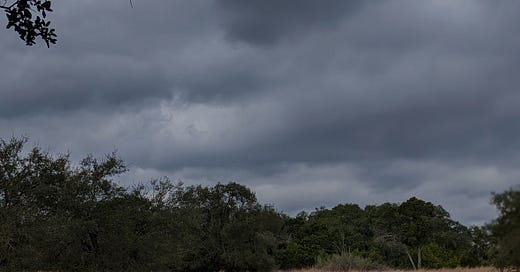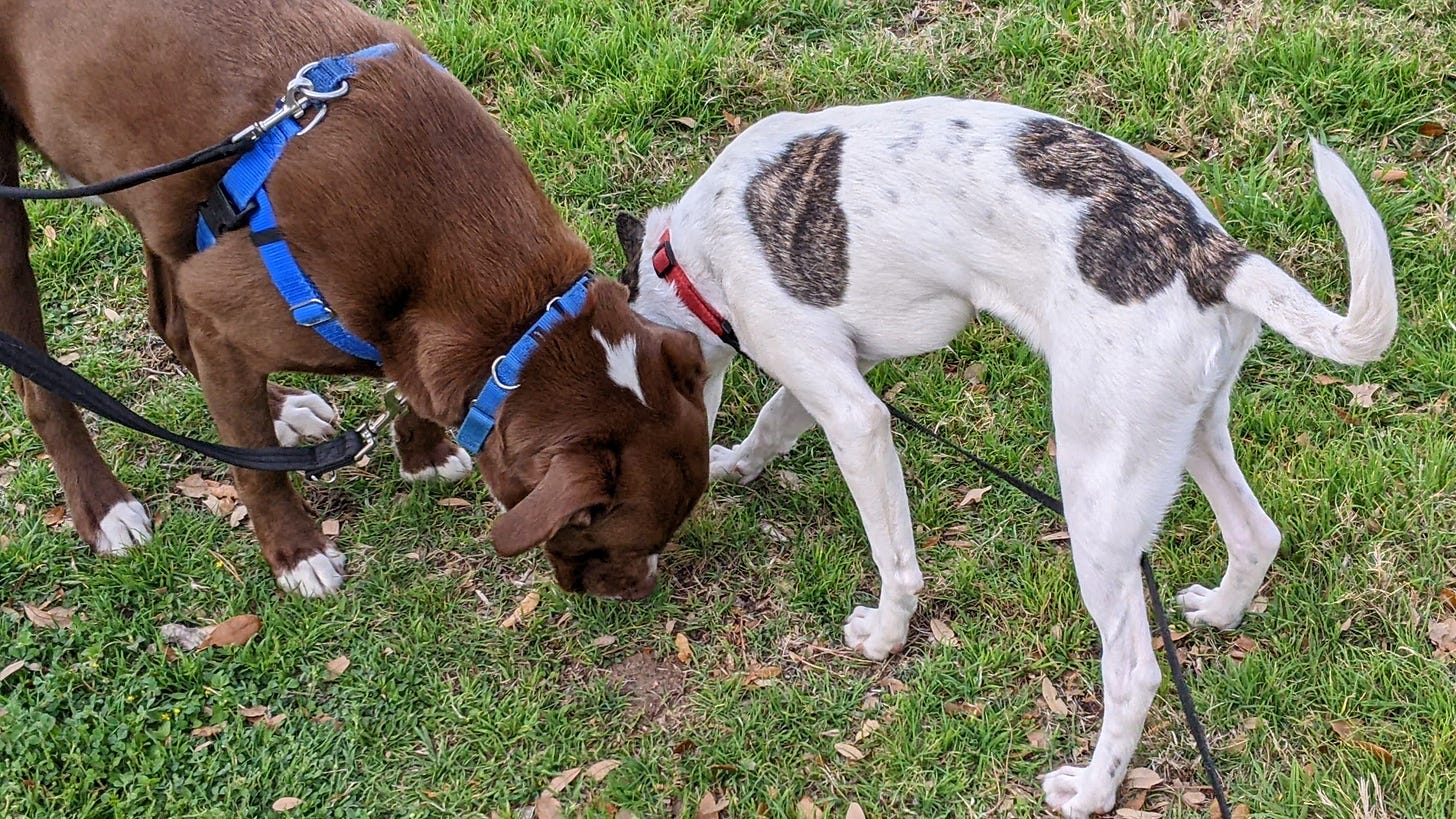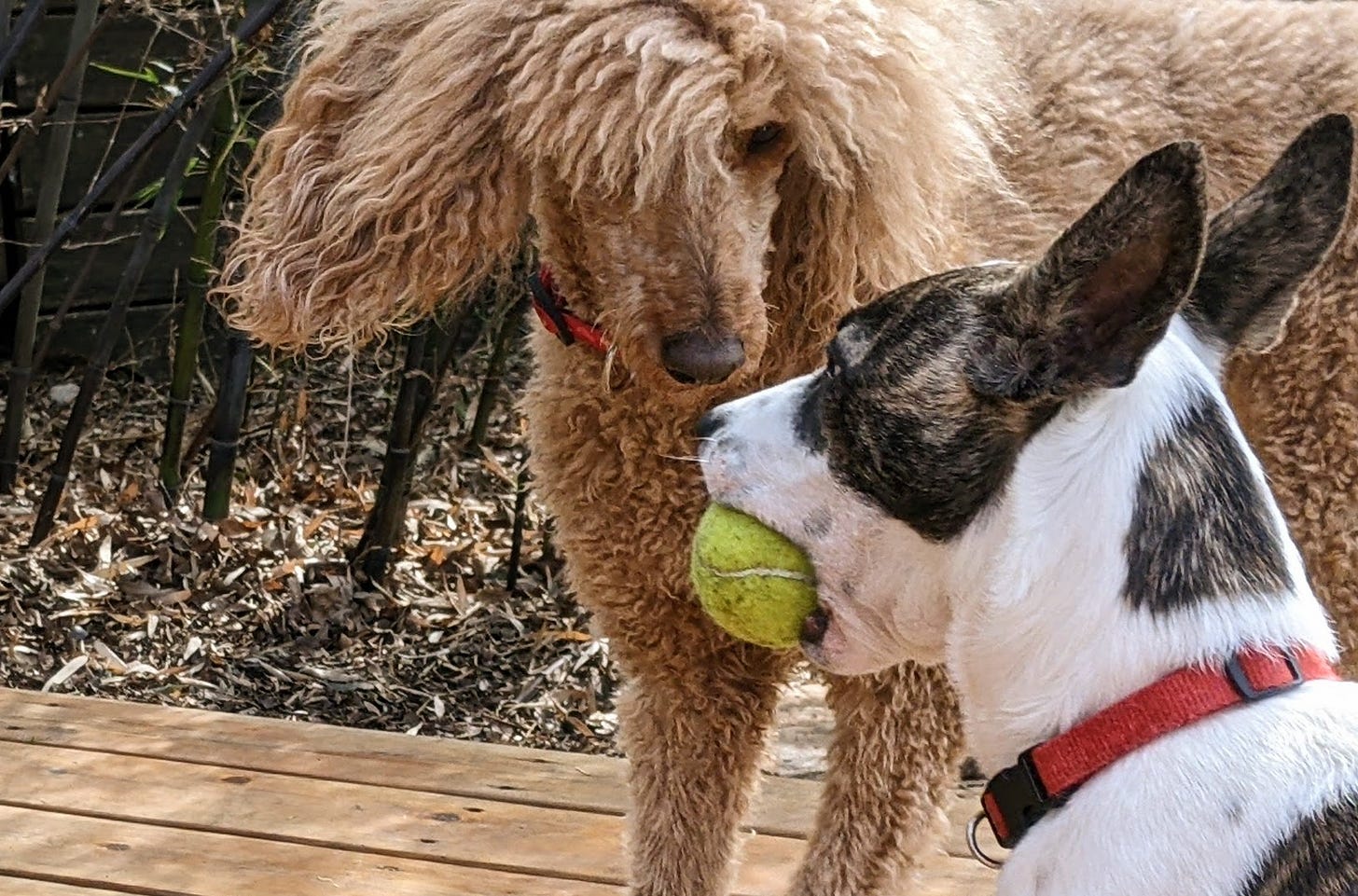There’s lots of confusion in these areas, so I’m banging on to make clear that 1) predation is not aggression, 2) aggression is a tool to increase social distance, esp. to retain access to resources, and 3) predatory drift, while relatively uncommon, is also distinct from aggression. Predatory drift happens when one dog ceases to recognize another as a dog, and sees that dog as prey instead.
For example:
A few days ago the resident dogs gamboled about in the backyard like big, carnivorous lambs. I sat on the deck drinking coffee until the chihuahua got a toe stuck between the deck boards and started screaming. The poodle - yes, that’s my ‘advanced’ therapy dog - rushed over and ‘attacked’1 the little dog who was still yelping to the high heavens. And the three other dogs hurried over to pile on because that’s what dogs do: pack up and pile on.
Meanwhile I’m trying to put my coffee down, grab Maggie by the scruff, liberate the chihuahua and fend off the other dogs with my free hand & both feet.
BTW no dogs were harmed in the scrum!
So what happened?
Predation is eating behavior. When dogs chase things they they want to put in their mouths, that’s predation. We see dogs practice predatory behavior in play every day. Play exercises and refines skills, specifically those Fixed (or Modal) Action Patterns used for survival strategies: to find enough to eat, avoid being eaten, avoid injury and disease, and reproduce. Play - the practice of this serious business - is marked by meta-signals, including play-bows, play-face (usually with a happy-looking open mouth), role reversals, pauses in activity and inefficient ‘rocking horse’ gaits. Often play just looks goofy. If dogs begin to get too serious and the activity stops looking like fun (say, flattening out in a chase or refusing to take a break from wrestling) we humans may break it up. After all, it’s fun and games until somebody ends up in a cone.
Of course dog play - not unlike kid play - can turn into a squabble. If a dog gets hurt, he may snap and act aggressively (to get space). Dog-dog aggression can also be a dog fight triggered by conflict over a resource. Most dog fights are lots of noise with little if any damage, but you also want to keep an eye on your dog’s emotional state. If you have concerns, break it up; there’s no downside to taking a break. Sometimes dogs will play again after they’re given a chance to cool off; sometimes not.
Predatory drift, on the other hand, is a special phenomenon. Predatory drift is a social conspecific - a dog playmate - somehow triggering another dog’s predatory behaviors. Remember the sharks in Finding Nemo? ‘Fish are friends, not food’? Good motto until the sharks are accidentally triggered by the smell of blood. You wouldn’t call it predatory drift in this case (since sharks do normally eat other fish), but that’s the idea. A trigger sets the predatory cycle in motion, and an animal - like a dog - responds with whatever pieces of the predatory cycle it has.
Squealing, thrashing, “acting like prey” are triggers for predatory drift. The risk of harm is greatest with size imbalance - big dogs on small - or two (or more) on one. Dogs respond to other dogs via local enhancement (“Whatchya lookin’ at?”) or social facilitation (“Me too! Me too!”). To us it looks like packing up.
A friend recounted a recent catastrophe on her farm. All of her goats were killed. Every single goat.2 A coyote, she said, will kill one goat and carry it off to eat. But loose dogs, with their wonky and partial FAPs, will respond to the trigger (goats as prey) with the pieces of the predatory FAP cycle they’ve inherited. The complete cycle starts with identifying prey and ends with eating: something like ‘orient - stalk - chase - grab-bite - kill-bite - dissect - consume.’ This is how all wild carnivores make a living. When coyotes and foxes and wolves aren’t scavenging, they need a complete working predatory cycle. Dogs, on the other hand, do not. Seriously, dogs evolved eating garbage! So later on humans tried their hands at genetic selection, pulling out particular features of dogs' FAPs helpful to humans. Hunting dogs are bred for particular pieces of the predatory cycle that help hunters. Terriers and many hounds tend to dissect/ kill their quarry, whereas retrievers are selected and trained for soft mouths to deliver prey (killed by the hunter, not the dog) without crushing or dismembering it. So by the same token, our dogs may not kill what they catch; or if dogs kill what they catch, they may not eat it.
Thus most pet dogs have a broken predatory cycle. The cycle’s off-switch is eating prey. But if dogs don’t eat the prey that triggers their predatory FAPs, there’s effectively no off-switch. Instead, dogs who do have chase, grab-bite and kill-bite in their repertoire are stuck in a loop, chasing, grabbing and killing until there are no triggers - that might be somebody’s sheep or goats - left alive.
And in this awful story, after killing all the goats at my friend’s farm, the loose dogs went to the next farm and killed 40 sheep. The donkeys, incidentally, did not intervene. It was incredibly bad luck that these particular loose dogs were killers. Because they wouldn’t have to be - they’re just dogs, after all.
When the chihuahua got her toe stuck, she screamed and thrashed around. The poodle, who’s a fetch maniac (that’s the chase and grab-bite parts of the predatory cycle), rushed over, barking and snapping, which brought all the other dogs over. I don’t think Maggie the poodle is a finisher. I don’t think she’d kill something on purpose (accidents can happen). She doesn’t dissect and she won’t eat raw food. What scared me is that Maggie’s chasing behavior got the other dogs’ attention, at least one of which IS a finisher. If he’s capable of killing rats and squirrels, would he kill a squealing chihuahua? If you can imagine a large dog grabbing a small dog in his mouth and shaking it - like terriers shake a rat - don’t take any chances. The chihuahua was a friend, not food, a minute ago, but now all bets are off.
Is predatory drift more common in drivey, predatory dogs? Seems reasonable, but we don’t know. How common is predatory drift? Once again, we don’t know. Dogs do sometimes kill other dogs. When is it a blood feud and when is it predatory drift?
Some dogs are intolerant of other dogs & just want to fight. These are usually ‘game’ dogs from fighting lines. Not only do they want to fight other dogs, they don’t give up or back down (hello, terrier friends!). This is not predation. In the case of game dogs, it’s a social deficit. While some trainers claim success in rehabilitating these dogs, the safest strategy is to prevent game dogs, who want to fight and injure other dogs, from having dog-access. No more dogs for them, ever. Somewhat paradoxically, game dogs are typically pro-social with humans (and tend not to redirect on human handlers); so they make wonderful pets except for the wanting-to-fight-dogs-all-the-time stuff.
I personally believe some dog-dog fatalities are just stupid accidents. Two of my dogs had an argument over some resource or other and the bigger dog with the bigger teeth happened to catch the smaller dog by the neck. The little dog pulled away, leaving a unidirectional tear a millimeter or so from his jugular. A couple millimeters more to the left, and the little dog would’ve bled out before anything could’ve been done to save him. While the injury could have been quite serious, I doubt the other dog’s intent was murder. Although to be fair, I don’t know.
Let me emphasize this point. This is why big-on-small gives people the heebie-jeebies: because it’s much easier to imagine a tiny miscalculation on either dog’s part resulting in serious injury to the little guy.
Do I know what the bigger dog’s intent was? Nope, I don’t, not at all. But a dog who’s had lots of dog-dog scraps without sending anybody to the vet hospital before has a good mouth and a good fight/ bite ratio. Nonetheless, dogs are equipped with essentially the same teeth that wolves use to carve up elk, moose, and caribou. You, human, have you ever tried to bite into an elk? With the fur on? Can you crack shin bones with your teeth? But large dogs do this. Their teeth and jaws deserve our considerable and unrelenting respect. Every time dogs snap at us & miss, every time they bite us without causing damage, we should be filled with awe at the precision control these animals exert over their bone-crushing weaponry.
(As it turned out, the doc patched the little dog up & he came home as feisty as ever. Terriers are not quick to learn deescalation strategies, in my experience. Resource management is key.)
So for safety around the house, consider: is your dog a finisher? Lots of dogs chase squirrels, but what happens if they catch one? Anecdotes abound on the topic of Labradors or goldens catching a hapless prey animal and either releasing it or perhaps delivering it gently to a non-plussed owner.
Whereas wolves are clear on the concept of dinner-on-the-hoof, many - most? - dogs are not. All successful wolves inherit a complete predatory fixed action pattern. It’s ‘instinctive’ and requires no learning, although wolves will refine their techniques over time. The wolf biologist L. David Mech in the 1970s first described the predatory sequence: orienting toward the prey (sight, scent, sound), stalk, chase, grab-bite, kill-bite (or kill-shake), dissect, consume.
For the tens of thousands of years that dogs have occupied an evolutionary niche distinct from that of wolves, dogs’ ingratiating garbage-scavenging abilities have been privileged at the expense of their predatory prowess. Certainly dogs have been selectively bred for specialized skills, like scent hounds, sight hounds, collies, guardians, etc. In one of his books (either Dogs or How Dogs Work), Ray Coppinger describes a rancher horrified at finding a herd guardian dog eating a dead lamb. These dogs are socialized with their flock, so herd guardian dogs treat sheep as social conspecifics, i.e., their pack. Dogs don’t eat dogs, and these herd guardians don’t ordinarily eat sheep, either. What happened in this case was that the lamb was disembowelled (by an accident involving barbed wire, as I recall). While this dog would have starved before dissecting a lamb, a lamb already dissected was available to eat & triggered the consumption element in the predation FAP. That’s how powerful fixed action patterns are, and that’s just one example of humans’ selection pressure on the FAPs dogs have inherited.
But we don’t always recognize the triggers. What we can do is always intervene when we have big-on-small or two-on-one. Accidents happen, but it doesn’t have to be on your watch.
In addition, there are differences between a dog chasing a squirrel (predation), a dog chasing another dog in play (yep, that’s play), a dog chasing another dog away from herself or her resources (aggression), or a dog chasing another dog because of a predation trigger (predatory drift). Remember those Pixar sharks? They were fine, until they were triggered. After the sharks were triggered, they became killing machines. How else do carnivores survive? That’s a predatory FAP in action: catch, kill, eat. It’s not aggression (machines don’t feel aggression). When your dog chases cats, it’s most likely predation. Your dog is probably not afraid of the cat and therefore aggressive toward the cat - your dog is triggered to chase small animals that flee. Cats that flee behave like prey.
So how do you fix THAT?
Pro tip: not with Pavlovian counter-conditioning. Your dog already likes that cat. Your dog wants to get close enough to put that cat in her mouth.
Predation is serious business for owners, because failure to manage or prevent it puts other animals at mortal risk. Dogs are animals, and animals bite. Predation for many dogs is a primordial drive. That doesn’t mean we can’t modify it, however, as long as we recognize the risks and choose the best training and management strategies.
Next post: the many virtues of our friend the DRI.
‘Attacked’ in scare quotes because she made horrible noises but didn’t connect.
A perfect storm. One herd guardian dog had died; the remaining dog was lonely, and made a habit of running off to visit nearby dogs. Since the night was cold, my friend had locked him inside. In other words, Hercules - the dog - was not a well-trained herd guardian. He doesn’t think of the goats as being his ‘pack’ (if you’ll forgive the word).
Our municipal shelter crisis:
https://www.kxan.com/investigations/neighbors-worry-about-abandoned-dogs-outside-austin-city-limits/







